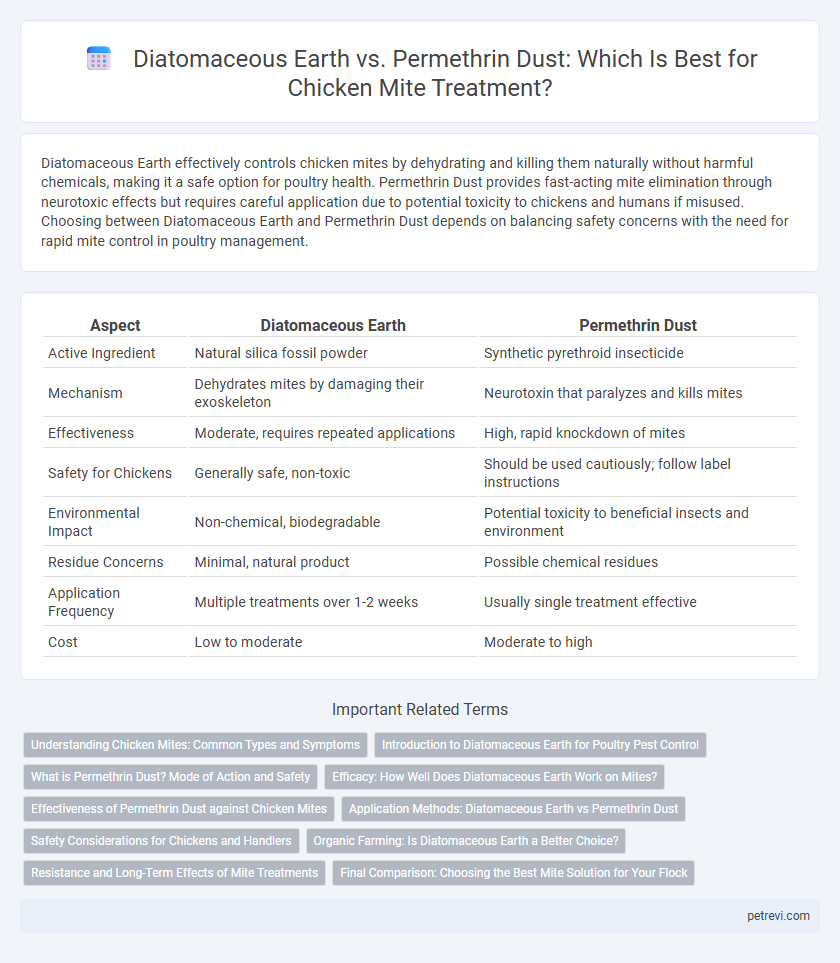Diatomaceous Earth effectively controls chicken mites by dehydrating and killing them naturally without harmful chemicals, making it a safe option for poultry health. Permethrin Dust provides fast-acting mite elimination through neurotoxic effects but requires careful application due to potential toxicity to chickens and humans if misused. Choosing between Diatomaceous Earth and Permethrin Dust depends on balancing safety concerns with the need for rapid mite control in poultry management.
Table of Comparison
| Aspect | Diatomaceous Earth | Permethrin Dust |
|---|---|---|
| Active Ingredient | Natural silica fossil powder | Synthetic pyrethroid insecticide |
| Mechanism | Dehydrates mites by damaging their exoskeleton | Neurotoxin that paralyzes and kills mites |
| Effectiveness | Moderate, requires repeated applications | High, rapid knockdown of mites |
| Safety for Chickens | Generally safe, non-toxic | Should be used cautiously; follow label instructions |
| Environmental Impact | Non-chemical, biodegradable | Potential toxicity to beneficial insects and environment |
| Residue Concerns | Minimal, natural product | Possible chemical residues |
| Application Frequency | Multiple treatments over 1-2 weeks | Usually single treatment effective |
| Cost | Low to moderate | Moderate to high |
Understanding Chicken Mites: Common Types and Symptoms
Chicken mites, including Northern fowl mites, red mites, and tropical fowl mites, are common parasites that cause irritation, feather loss, and anemia in poultry. Symptoms such as pale combs, reduced egg production, and restlessness indicate mite infestation. Effective treatment begins with accurate identification of mite species and symptom severity to choose between Diatomaceous Earth's abrasive dehydration method or chemical control with Permethrin Dust.
Introduction to Diatomaceous Earth for Poultry Pest Control
Diatomaceous Earth (DE) is a natural, non-toxic powder made from fossilized remains of diatoms, effective in controlling poultry mites by dehydrating and killing them on contact. Unlike chemical treatments like Permethrin Dust, DE is safe for chickens, humans, and the environment, making it ideal for organic poultry farming. Its abrasive properties disrupt the protective layer of mites, offering a sustainable and chemical-free solution for poultry pest management.
What is Permethrin Dust? Mode of Action and Safety
Permethrin dust is a synthetic chemical insecticide widely used for controlling chicken mites by disrupting their nervous system, causing paralysis and death. Its mode of action involves interfering with sodium channels in the mites' nerve cells, leading to rapid knockdown and elimination. Permethrin dust is effective but must be applied carefully to avoid toxicity in chickens, as improper use can cause irritation or poisoning, thus following label instructions and safety precautions is essential.
Efficacy: How Well Does Diatomaceous Earth Work on Mites?
Diatomaceous earth works effectively against chicken mites by physically damaging their exoskeletons, leading to dehydration and death, without the use of chemicals. Studies show that its mineral-based composition provides a non-toxic, natural alternative that can reduce mite populations, though results may vary with moisture and application frequency. Compared to permethrin dust, which chemically targets and kills mites instantly, diatomaceous earth offers a slower, but safer and eco-friendly method for long-term mite control in poultry environments.
Effectiveness of Permethrin Dust against Chicken Mites
Permethrin dust exhibits high effectiveness against chicken mites by disrupting their nervous system, leading to rapid mite elimination and reduced reinfestation risk. Studies demonstrate its ability to provide lasting protection when applied according to directions, often outperforming diatomaceous earth, which primarily works through physical abrasion. Proper dosage and safety precautions are critical to avoid toxicity in poultry and ensure optimal treatment outcomes.
Application Methods: Diatomaceous Earth vs Permethrin Dust
Diatomaceous Earth is typically applied by dusting it directly onto chickens and their coop, creating a physical barrier that dehydrates and kills mites through abrasive contact. Permethrin Dust requires careful application by spreading it on the chicken's feathers and bedding, delivering a chemical insecticide that targets the mites' nervous system. Both methods must be applied in dry conditions to maximize effectiveness, with Diatomaceous Earth favored for its natural properties and Permethrin for its rapid mite eradication.
Safety Considerations for Chickens and Handlers
Diatomaceous earth is a natural, non-toxic option that is safe for chickens and handlers when used properly, effectively dehydrating and eliminating mites without chemical residues. Permethrin dust, while highly effective against chicken mites, poses potential toxicity risks, especially to young chickens and humans if inhaled or ingested, requiring careful application and protective measures. Choosing between these treatments involves weighing the safety profile of diatomaceous earth against the potent but more hazardous nature of permethrin dust.
Organic Farming: Is Diatomaceous Earth a Better Choice?
Diatomaceous Earth (DE) offers a natural, chemical-free solution for chicken mite treatment, making it ideal for organic farming practices by minimizing harmful residues and promoting animal welfare. Permethrin dust, although effective, contains synthetic chemicals that may not meet organic certification standards and can pose risks to beneficial insects and environmental safety. Choosing DE supports sustainable pest control, aligning with organic farming principles while effectively managing mite infestations in poultry.
Resistance and Long-Term Effects of Mite Treatments
Diatomaceous Earth provides a natural, non-chemical approach to chicken mite treatment, minimizing the risk of resistance development in mite populations due to its physical dehydration mechanism. Permethrin dust, while effective initially, can lead to mite resistance over time because of its neurotoxic chemical action, which targets the mites' nervous systems. Long-term use of permethrin may also pose toxicity risks to chickens and the environment, whereas diatomaceous earth offers a safer, more sustainable option for ongoing mite control in poultry management.
Final Comparison: Choosing the Best Mite Solution for Your Flock
Diatomaceous Earth offers a natural, chemical-free approach to mite control by dehydrating pests, making it safer for chickens and organic farming practices. Permethrin dust provides fast-acting, synthetic insecticidal effects but may pose toxicity risks to birds and require careful application. Selecting the best treatment depends on balancing immediate mite eradication needs with long-term flock health and environmental safety.
Diatomaceous Earth vs Permethrin Dust for Chicken Mite Treatment Infographic

 petrevi.com
petrevi.com